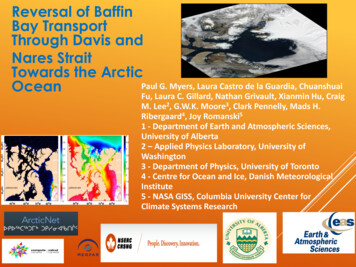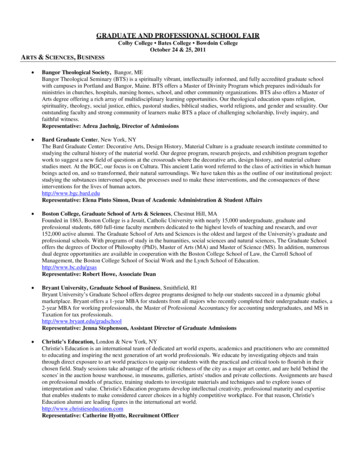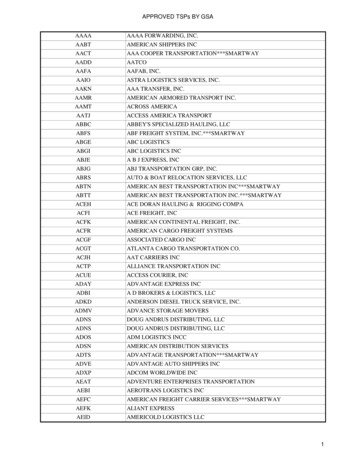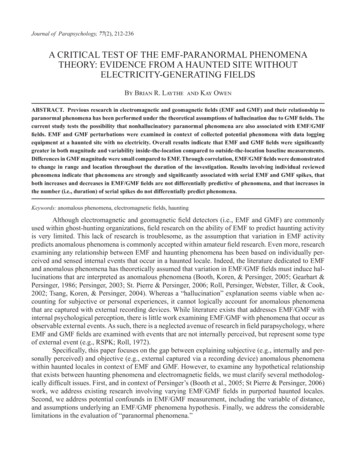
Transcription
NOTES ON TRANSPORTPHENOMENAR Shankar SubramanianUPDATED AUGUST 1, 2020DEPARTMENT OF CHEMICAL AND BIOMOLECULAR ENGINEERING, CLARKSON UNIVERSITYPotsdam, New York 13699-5705
Introductory RemarksThese notes were developed to support an introductory graduate level course on transportphenomena at Clarkson University that I taught for many years, and later also used to supplementmaterial from the textbook by R.B. Bird, W.E. Stewart, and E.N. Lightfoot titled “TransportPhenomena” in my undergraduate elective course on the subject. The notes should not beconstrued as complete in the sense of being useful as a textbook for any course. Rather, theycontain a variety of sections that I wrote over the years to provide supplemental material forstudents taking my courses, and only reflect my style and bias in presenting topics.Because of the manner in which these notes were formulated and modified over the last threedecades, the various parts were written nearly independently of each other, and each sectioncontains its own set of references.In preparing and refining these notes, I have learned much from the students who took my coursesas well as colleagues at Clarkson and elsewhere, to whom I shall remain grateful forever.Any errors in this document are entirely my responsibility. I can be reached atR. Shankar SubramanianProfessor EmeritusDepartment of Chemical and Biomolecular EngineeringClarkson UniversityPotsdam, New York 13699subramanian@clarkson.eduJuly 2020Update 1, August 2020 (minor edits in Section II)1
Table of ContentsPart I: Introduction to Vectors and Tensors3Part II: Continuity Equation, Kinematics of Fluid Motion, Navier-Stokes Equation,Procedure for Setting up Problems, Boundary Conditions17Part III: Example Problems in Fluid Flow50Part IV: Mathematical Techniques: Solution of Partial Differential Equations68Part V: Scaling of Navier-Stokes Equation, Reynolds Number, Boundary Layer Theory87Part VI: Introduction to Energy Transport109Part VII: Graetz Problem and Lévêque Approximation118Part VIII: Thermal Boundary Layer, Buoyant Convection andSurface Tension Driven Flow132Part IX: Introduction to Mass Transport156Part X: Simple Example Problems in Mass Transport165Part XI: Film and Penetration Models1752
Part IIntroduction to Vectors and Tensors3
Introduction to Vectors and TensorsSome useful references for learning about vectors and tensors are the books listed as references atthe end.Some BasicsWe encounter physical entities such as position, velocity, momentum, stress, temperature, heatflux, concentration, and mass flux in transport problems - there is a need to describe them inmathematical terms and manipulate the representations in various ways. This requires the tools oftensor analysis.ScalarsAn entity such as temperature or concentration that has a magnitude (and some units that need notconcern us right now), but no sense of direction, is represented by a scalar.VectorsIn contrast, consider the velocity of a particle or element of fluid; to describe it fully, we need tospecify both its magnitude ( in some suitable units) and its instantaneous spatial direction. Otherexamples are momentum, heat flux, and mass flux. These quantities are described by vectors. Inbooks, vectors are printed in boldface. In ordinary writing, we may represent a vector in differentways. v, v, vGibbs notationorviindex notationThe last requires comment. Whereas we represent the vectorial quantity with a symbol, we oftenknow it only via its components in some basis set. Note that the vector as an entity has an invariantidentity independent of the basis set in which we choose to represent it.In index notation, the subscript “i” is a free index - that is, it is allowed to take on any of the threevalues 1, 2, 3, in 3-dimensional space. Thus, vi really stands for the ordered set ( v1 , v2 , v3 ) .Basis SetsThe most common basis set in three-dimensional space is the orthogonal triad( i , j, k )corresponding to a rectangular Cartesian coordinate system. i stands for a unit vector in the x direction and j and k represent unit vectors in the y and z directions respectively. Note thatthis is not a unique basis set. The directions of i , j , k depend on our choice of the coordinatedirections.4
There is no reason for the basis set to be composed of orthogonal vectors. The only requirementis that the three vectors chosen do not lie in a plane. Orthogonal sets are the most convenient,however.We find the components of a vector in the directions of the base vectors by taking inner (dot)products.vx v i , vy v j , vz v kThen, v vx i v y j vz kYou can verify the consistency of the above by taking inner products of both sides of the equationwith the base vectors and recognizing that the base vectors are orthogonal.i j j k k i 0The order of the vectors in the inner product is unimportant.a b b aScalar and Vector FieldsIn practice the temperature, velocity, and concentration in a fluid vary from point to point (andoften with time). Thus, we think of fields - temperature field, velocity field, etc.In the case of a vector field such as the velocity in a fluid, we need to represent the velocity atevery point in space in the domain of interest. The advantage of the rectangular Cartesian basisset i , j , k is that it is invariant as we translate the triad to any point in space. That is, not only()are these base vectors of unit length, but they never change direction as we move from one pointto another, once we have chosen our x, y, and z directions.Vector OperationsThe entity v has an identity of its own. Its length and spatial direction are independent of thebasis set we choose. As the vectors in the basis set change, the components of v change accordingto standard rules.Vectors can be added; the results are new vectors. If we use component representation, we simplyadd each component. Subtraction works in a similar manner.Vectors also can be multiplied, but there is more than one way to do it. We define the dot andcross products, also known as inner (or scalar) and vector products, respectively, as shown below.a b ax bx a y by az bz is a scalar. We commonly use a numerical subscript for the components;5
()in this case, the basis set is the orthogonal triad e (1), e ( 2) , e (3) . Leta a1 e (1) a2 e ( 2) a3 e (3)Then,a b a1b1 a2b2 a3b33 ai bii 13In the above, we usually omit . When an index is repeated, summation over that index isi 1implied.a b ai biThis is called the Einstein summation conventiona a ai ai a 2 or a2where a is the length of a and is invariant; “invariant” means that the entity does not change asthe basis set is altered.a b is the vector product. As implied by the name, it is a vector; it is normal to the planecontaining a and b . ( a , b , a b ) form a right-handed system (this is an arbitrary convention ,but we have to choose one or the other, so we choose “right”). The order is important, for,a b b athat is, b a points opposite to a b .We can writee (1)a b a1b1e ( 2)a2b2e ( 3)a3b3There is a compact representation of a determinant that helps us writea b ε ijk ai b j(Note that k is a free index. The actual symbol chosen for it is not important; what matters isthat the right side has one free index, making it a vector)6
ε ijk is called the permutation symbolε ijk 0 if any two of the indices are the same 1 if i, j , k form an even permutation of 1, 2, 3 [example: 1,2,3] 1 if i, j , k form an odd permutation of 1, 2, 3 [example: 2, 1, 3]We can assign a geometric interpretation to a b and a b . If the angle between the two vectorsa and b is θ , thena b a b cos θand the length of a b is a b sin θ . You may recognize a b sin θ as the area of the parallelogramformed by a and b as two adjacent sides. Given this, it is straightforward to see thata b c ε ijk ai b j ckis the volume of the parallelepiped with sides a , b , and c . This is called the triple scalar product.Second Order TensorsNote that we did not define vector division. The closest we come is in the definition of secondorder tensors!Imaginea ΤbInstead, we writea Τ bA tensor (unless explicitly stated otherwise we’ll only be talking about “second-order” and shalltherefore omit saying it every time) “operates” on a vector to yield another vector. It is very usefulto think of tensors as operators as you’ll see later.Note the “dot” product above. Using ideas from vectors, we can see how the above equation maybe written in index notation.7
ai Τij b jIt is important to note that b Τ would be bi Τij and would be different from Τ b in general.The two underbars in Τ now take on a clear significance; we are referring to a doubly subscriptedentity. We can think of a tensor as a sum of components in the same way as a vector. For this, weuse the following result.e (i ) Τ e ( j ) ΤijScalarWe’re not using index notation on the left side of the above equality.Thus, to get Τ23 we would find e ( 2) Τ e (3) . We can then think of T as a sum.Τ Τ11 e (1) e (1) Τ12 e (1) e ( 2) Τ13 e (1) e (3) Τ21 e ( 2) e (1) Τ22 e ( 2) e ( 2) Τ23 e ( 2) e (3) Τ31 e (3) e (1) Τ32 e(3) e ( 2) Τ33 e (3) e (3)What are the quantities e (1) e ( 2) and others like them? They are called dyads. They are a basisset for representing tensors. Each is a tensor that only has one component in this basis set. Notethat e(i ) e ( j ) e ( j ) e (i ) . A dyadic product is a third way in which we can multiply two vectors.You can see that tensors and matrices have a lot in common!In fact, we commonly write the components of a tensor as the elements of a 3 x 3 matrix. Τ11 Τ12 Τ13 Τ21 Τ22 Τ23 Τ Τ Τ 31 32 33 Naturally, as we change our basis set, the components of a given tensor will change, but the entityitself does not change. Of course, unlike vectors, we cannot visualize tensors – we only “know”them by what they do to vectors that we “feed” them!A good example of a tensor in fluid mechanics is the stress at a point. To completely specify thestress vector, we not only need to specify the point, but also the orientation of the area element.At a given point, we can orient the area in infinitely many directions, and for each orientation, thestress vector would, in general be different.8
Stress Force has magnitude and directionArea has magnitude and directionIn fact, we can show that stress is indeed a tensor (for proof, see Aris, p. 101). So, we gett n ΤntThe symbol n represents the unit normal (vector) to the area element, and t is the stress vectoracting on that element. The second-order tensor Τ completely describes the state of stress at apoint. By convention, t is the stress exerted by the fluid into which n points on the fluid adjoiningit.Just as a vector has one invariant (its length), a tensor has three invariants. They are defined asfollows.Let A or Aij be the tensor. abbreviation I A trace { A} Aii{ A} tr II A1 2I A II A where 2 II A tr { A A}Note: A A is the tensor Aij AjkIII A Determinant of A Det { A} ε ijk A1i A2 j A3k ε ijk Ail Aj 2 Ak 39
As the basis set is changed, the invariants do not change even though the components of the tensormay change. For more details, consult Aris, p. 26, 27 or Slattery, p. 47, 48.A symmetric tensor Aij is one for which Aij Aji . Thus, there are only six independentcomponents. Stress is a symmetric tensor (except in unusual fluids). Symmetric tensors with realelements are self-adjoint operators, a concept about which you can learn more in advanced work.A skew-symmetric tensor Aij is one for which Aij Aji . You can see immediately that thediagonal elements must be zero ( because Aii Aii ) . Skew-symmetric tensors have only threeindependent components. Vorticity is an example of a skew symmetric tensor.If we write a skew-symmetric tensor Aij in the form 0 a3 a2a30 a1 a2 a1 0 We can see that there is a vector a that can be formed using the elements of Aij . The two arerelated by the following result, which is useful in the context of the physical significance ofvorticity.A x x aAny second order tensor can be decomposed into the sum of a symmetric tensor and a skewsymmetric tensor.Aij 1111A AT )Aij Aji ) ( Aij Aji ) or in Gibbs notation, A ( A AT ) ((222 2 Symmetric TensorSymmetric TensorSkew-Symmetric TensorSkew-Symmetric TensorHere, AT is the transpose of the tensor A . AT has components that form a matrix whose columnsare the rows of the matrix of components of A .There is a special tensor that leaves a vector undisturbed. It is called the identity or unit tensor I. 1 0 0 I x x I 0 1 0 for any x 0 0 1 In index notation, we write I as δ ij , the Kronecker delta.10
Symmetric tensors have a very special property. Remember that we define a tensor as therepresentation of some field at a point; at that point, there are three special directions, orthogonalto each other, associated with a symmetric tensor. When the tensor operates on a vector in oneof these directions, it returns another vector pointing in the same (or exactly opposite) direction!The new vector, however, will have a different length in general. This multiplication factor in thelength is called the principal value or eigenvalue of the tensor. If the eigenvalue is negative, theoutput vector from the operation will point opposite to the input vector.Because there are, in general, three directions that are special, there are usually three distinctprincipal values, one associated with each direction. Even for tensors that are not symmetric, thereare three principal values; however these need not all be real. Sometimes, two are complex. Evenwhen the principal values are real, the directions associated with them need not be orthogonal ifthe tensor is not symmetric.The problem for the principal or eigenvalues of A isA x λ x λ I xTherefore, A λ I x 0From linear algebra, for non-trivial solutions of the above system to exist, we must havedet A λ I 0The resulting third degree equation for the eigenvalues is λ 3 I Aλ 2 II Aλ III A 0and has three roots λ1 , λ2, and λ3 . When these roots are each used, in turn, and we solve for x ,we obtain an eigenvector that is known only to within an arbitrary multiplicative constant.Commonly, the eigenvector is normalized so that it has unit length.From the above, you can see that corresponding to a symmetric tensor, there is a special rectangularCartesian set of basis vectors of unit length. If we choose this as the basis set, the tensor will havea simple diagonal form with the diagonal components being the eigenvalues.If you’re wondering what happens when two eigenvalues are identical, it is easy to show that anyvector in the plane normal to the third eigenvector (corresponding to the third eigenvalue) isacceptable as an eigenvector. In other words, on that plane, the tensor operating on a vector in anydirection will yield a vector in the same direction with a magnification factor corresponding to therepeated eigenvalue.11
If all three eigenvalues are identical, then any direction in space will be acceptable as the directionof the eigenvectors. Such a tensor is called isotropic for this reason. I is an isotropic tensor witheigenvalues equal to unity. Any scalar multiple of I also is isotropic.Vector CalculusIf we consider a scalar field such as temperature, we find the rate of change with distance in somedirection, x , by calculating Τ x . How can we represent the rate of change in three-dimensionalspace without specifying a particular direction? We do this via the gradient operator. The entity Τ [we call it “grad T”] is a vector field. In index notation we write the gradient operator as / xi where i is a free index, so that Τ T / xi .At a given point in space, the vector Τ points in the direction of greatest change of T. To obtainthe rate of change of T at that point in any specified direction, n , we simply “project” Τ in thatdirection. Τ Τ n nunit vectorSurfaces in space on which a field has the same value everywhere are level surfaces. In the caseof temperature fields, these surfaces are called isotherms. Along such a surface, the temperaturecannot change. Therefore, the Τ vector is everywhere normal to isothermal surfaces since itmust yield a value of zero when projected onto such surfaces.It is straightforward to establish from the definition that e (1) e ( 2) e ( 3) x1 x2 x3in a rectangular Cartesian coordinate system ( x1 , x2 , x3 ) .Note that is an operator and not a vector. So, you should exercise care in manipulating it.The operator is the generalization of a derivative. We can differentiate vector fields in morethan one way.Divergence v or div v is called the divergence of the vector field v . If the rectangular Cartesiancomponents of v are v1, v2 , v3 , then v v1 v2 v3 x1 x2 x3 viin index notation xi12
As you can see, the result is a scalar field. It can be shown that the divergence of a vector field atany point represents the outflow of the field.Curl v or curl v is a vector field. As the name implies, it measures the “rotation” of the vector v. Again, in ( x1, x2 , x3 ) coordinates, v e(1)e( 2)e ( 3) x1 x2 x3v1v2v3 ε ijk vkin index notation. x jThe term “curl” implies rotation, and the curl of a vector field is indeed related to rotation as willbe evident when we discuss fluid mechanics later.There are two important theorems you should know. They are simply stated here without proof.Divergence TheoremIf the volume V in space is bounded by the surface S , dS a a dVVSdSVS13
The vector field a should be continuous and differentiable. The symbol dS represents a vectorsurface element. If n is the unit normal to the surface,dS n dSThe entity dV is a volume element. In the theorem, the left side is a volume integral and the rightside is an integral over the surface that bounds the volume. Finally, a need not be a vector field,but can be a tensor field of any order.The divergence theorem, also known as Green’s transformation, is a very useful result thatpermits us to convert volume integrals into surface integrals. By applying it to an infinitesimalvolume, you can visualize the physical significance of the divergence of a vector field at a pointas the outward “flow” of the field from that point.Stokes TheoremThis permits the conversion of integrals over a surface to those around a bounding curve. Imaginea surface that does not completely enclose a volume, but rather is open, such as a baseball cap. LetS be the surface and C, the curve that bounds it.CtSIf a vector field a is defined everywhere necessary, and is continuous and differentiable, Stokestheorem states: a t ds ( a ) dSCSwhere dS is a vector area element on the surface S , ds is a scalar line element on the boundingcurve C, and t is a unit tangent vector on C.14
The integral on the right side is known as the circulation of a around the closed curve C. Thefield a appearing in the theorem can be replaced by a tensor field of any desired order.SCBy imagining the surface S to lie completely on the plane of the paper as shown, you can visualizethe physical significance of a . If you make S shrink to an infinitesimal area, the area integralon the left side becomes the product of the component of a normal to the plane of the paperand the area. The line integral is still the circulation around an infinitesimal closed loopsurrounding the point. If a is the velocity field v , by making the boundary an infinitesimalcircle of radius ε , the right side can be seen to be approximately 2πε v , where v is the magnitudeof the velocity around the loop. The left side is approximately πε 2 ( v) n where n is the unit1vnormal to the plane of the paper. Therefore, ( v) n , which becomes the instantaneous2εangular velocity of the fluid at the point on the plane of the paper as ε 0 . Because there is1nothing unique about the choice of the plane of the paper, we can see that ( v) in fact2represents the instantaneous angular velocity vector of a fluid element at a given point, thecomponent of which in any direction is obtained by projecting in that direction.15
The Gradient of a Vector FieldJust as we defined the gradient of a scalar field, it is possible to define the gradient of a vector ortensor field. If v is a vector field, v is a second-order tensor field. The rate of change of v inany direction n is given by v v n nConcluding RemarkIn this section of the notes, we have used symbols for vectors and tensors that are convenient forhandwritten work. In the remainder of these notes, we shall use the standard boldfacerepresentation of vectors and tensors found in books.References1. R. Aris, Vectors, Tensors, and the Basic Equations of Fluid Mechanics, Dover Publications,1989 (original by Prentice-Hall, 1962).2. R. B. Bird, W. E. Stewart, and E. N. Lightfoot, Transport Phenomena, John Wiley, 2007.3. J. Slattery, Momentum, Energy, and Mass Transfer in Continua, McGraw-Hill, 1972.16
Part IIContinuity Equation: Principle ofConservation of MassKinematics of Fluid MotionNavier-Stokes Equation: Principle ofConservation of MomentumProcedure for Setting up ProblemsBoundary Conditions17
Continuity Equation: Principle of Conservation of MassBased on observation, one can postulate the idea that mass is neither created nor destroyed. Inother words, it is conserved. This is termed the Principle of Conservation of Mass. This principleis applied to a fixed volume of arbitrary shape in space that contains fluid. This volume is calleda “Control Volume.” Fluid is permitted to enter or leave the control volume.A control volume V is shown in the sketch.ndSdVVSAlso marked on the sketch is the bounding surface S of this control volume, called the controlsurface; an element of surface area dS and the unit outward normal (vector) to that area element,n are shown as well. The vector symbol dS n dS is used to represent a directed differentialarea element on the surface.Just like the principle of conservation of mass, one can make similar statements about energy andmomentum, being careful to accommodate ways in which energy or momentum can enter or leavea fixed volume in space occupied by a fluid. These conservation statements are put inmathematical form and termed “integral balances.” These balances are useful in a variety ofproblems. Here, we shall apply the principle of conservation of mass to the control volume shownin the sketch, and eventually obtain a partial differential equation commonly known as thecontinuity equation. We begin with a verbal statement of the principle of conservation of mass.Rate of increase of mass of material within the control volume Net rate at which massenters the control volume.18
Let us write a mathematical representation of the above statement. To determine the rate ofaccumulation of mass in the control volume, we begin with the mass content in the differentialvolume element dV , because the density ρ of the fluid can depend on position. Multiplying thedifferential volume by the density at that location gives the amount of mass in the differentialvolume element, and the total mass M in the control volume V is obtained by integrating thisproduct over the entire control volume. Therefore,M ρ dVVThe time rate of change of this mass content in the control volume is dM / dt . Because the controlvolume is fixed in space, the time derivate can be taken inside the integral and becomes a partialderivate in time, obtained when keeping spatial coordinates fixed. Thus, the left side in the verbal ρdV , where t represents time.statement of the principle of conservation of mass is tVNow, we need to develop a result for the net rate of entry of mass into the control volume throughthe control surface. For this, we consider the differential area element dS . Now, let us define themass flux through space as the vector N M . Then the rate of entry of mass into the control volumethrough the area element dS is ( N M n dS ) , which is ( N M dS ) . The total rate of entry ofmass over the entire surface can be written as the integral ( NM dS ) . This is the right side inSthe verbal statement of the principle of conservation of mass. Equating the two sides yields thefollowing result. V ρdV N M dS tSor V ρdV t NM dS 0SA theorem that applies to vector fields permits us to convert a surface integral such as the one inthe above equation into a volume integral. It is known as the Gauss divergence theorem or Green’stheorem. The vector field must satisfy conditions regarding continuity of derivatives, and all thefields that we encounter are assumed to satisfy these conditions. Using this theorem, we can writethe following result. NMS dS ( N ) dVMVUsing this equality, we can rewrite the principle of conservation of mass as ρ tV N M dV 0 19
We wish to conclude that at every point in the fluid, the integrand of the above result must be zero.To do this we need to use two important ideas. One is that our control volume is arbitrary in shapeand location. The second is that the fields ρ , N M , and their derivatives are all continuousfunctions of position. Thus, the integrand is a continuous function of position. This means that ifthe integrand is non-zero at any point in space, we are guaranteed a neighborhood of that point inwhich it retains the same sign. Then, we can consider that specific neighborhood the controlvolume, in which case the integral will be non-zero, violating the integral balance stated above.This precludes the integrand being non-zero anywhere in the fluid. Thus, it must be zero at everypoint in the fluid. ρ NM 0 tThe mass flux is the product of the density and the volume flux, which is the velocity.N M ρvSubstituting this result in the partial differential equation yields the continuity equation. ρ ( ρv ) 0 tBy working out the divergence of the product, we can rewrite this as ρ v ρ ρ ( v ) 0 tIt is common practice to combine the first two terms in the left side and write the result as thematerial derivative of density with respect to time.dρ dt ρ v ρ tDρdρfor the material derivative. We shall usein our work. TheDtdtmaterial derivative is the time derivative taken while keeping the material coordinates fixed.Physically, this means that it is the time derivative obtained while moving with a material particle,i.e. moving with the flow.Bird et al. (1) use the symbol20
Thus, the continuity equation is rewritten asdρ ρ ( v ) 0dtThe assumption of incompressible flow, implying that the density of an element of fluid does notchange with a change in pressure, is used commonly. With this assumption, the continuity equationreduces to v 0In rectangular Cartesian coordinates ( x, y, z ) this is written as follows. vx v y vz 0 x y zAppropriate representations in other coordinate systems can be found in textbooks such as that byBird et al. (1).The Assumption of Incompressible FlowIncompressible flow implies that the variation in the density of an element of fluid due to changesin pressure can be considered negligible. Because pressure variations are encountered in fluids,one might wonder about the limits on the validity of this assumption. Liquids are virtuallyincompressible, displaying very small variations in density in response to pressure changes, so thatincompressible flow is almost always an excellent assumption in liquids. Gases, on the other hand,undergo a significant density change when the pressure is changed. In the flow of gases, theassumption of incompressible flow can be used so long as ρρ 1where ρ represents a typical change in density encountered in the flow, and the symbol standsfor “much less than.”As shown in pages 9-11 of Schlichting (2) this condition implies that the square of the ratio of acharacteristic velocity in the fluid v0 to the speed of sound c in the fluid, is much less than unity.2 v0 1 c 21
The Mach number M is defined asM v0cso that the requirement is that M 2 1. In practical terms, this means that the assumption ofincompressible flow in a gas is good so long as the Mach number is relatively small, that is, solong as the typical flow velocities are much smaller than the speed of sound in the fluid.A more detailed discussion of the conditions for the validity of the assumption of incompressibleflow, accounting also for thermal expansion, can be found in pages 167-171 of Batchelor (3).References1. R.B. Bird, W.E. Stewart, and E.N. Lightfoot, Transport Phenomena, Wiley, 2007.2. H. Schlichting, Boundary Layer Theory, McGraw-Hill, 1968.3. G. K. Batchelor, An Introduction to Fluid Dynamics, Cambridge University Press, 1967.22
Kinematics of Fluid MotionKinematics is the study of motion without dealing with the forces that affect motion. Thediscussion here is of limited scope and for more details, the reader is encouraged to consult any ofthe references listed at the end. The notation used and the details of the development in manyplaces are directly borrowed from Aris (1) and Batchelor (2). Our focus here is on fluid motion.We shall use rectangular Cartesian coordinates ( x, y, z ) , along with the associated basis set ofmutually orthogonal unit vectors ( i , j , k ) . The position vector is labeled x .Imagine a tiny line element dx , labeled PQ in the sketch, at some instant of time. After a smallamount of time dt , the two ends have moved to new locations because of fluid motion, and thenew line element is labeled P′Q′ .Q′QPP′We can see that if the velocity were to be the same at both ends of the element, it would changeneither its length, nor its orientation. Therefore, in a uniform velocity field, there is simpletranslation of fluid elements with no deformation or rotation. To cause either,
Aug 01, 2020 · These notes developed to support an were graduate level course on transport introductory phenomena at Clarkson University that I taught for many years, and later also used to supplement material from the textbook by R.B. Bird, W.E. Stewart, and E.N. Lightfoot titled “Transport Phenomena










